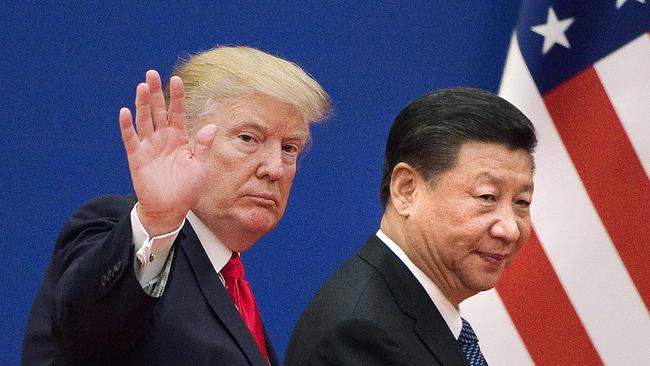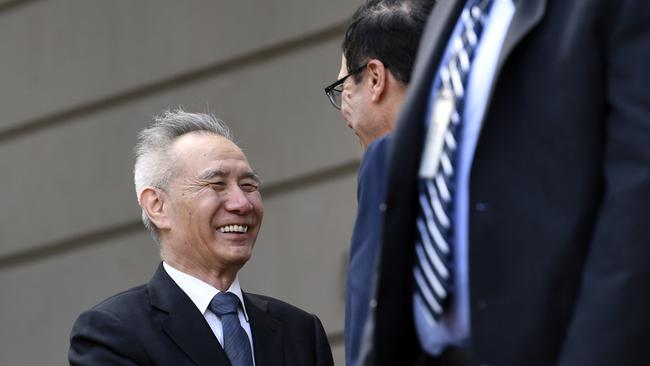
How do you claw it back?
It’s not easy when your opponent, President Donald Trump, is sitting on a booming US economy and can afford to call your bluff.
Trump believes China will suffer more from a trade war than the US. And it’s academic to him that Australia is vulnerable. I suspect he would not even know that our dollar is falling on fears that there will be no deal, or that any deal will reduce our trade with China.
The US strength over China is confirmed by the share market, with the Shanghai index suffering more than Wall Street since China back-pedalled.
Xi’s first step was simply to shift negotiating ground and retract earlier offers. Trump responded via a tweet -- the new method of global negotiation -- that he would raise tariffs by the end of the week.
The classic China response would have been to withdraw from this week’s trade talks.
In a sign of weakness, Xi decided to allow his envoy to meet President Trump, but the envoy does not seem to have as much power as he previously had.
Xi’s next step was to see if he could panic the US bond markets to put pressure on Trump.
China was absent from this week’s US bond tender. If ever China sold its huge holdings of US bonds and Treasury notes, US interest rates would skyrocket.
But China would also suffer and Xi is sitting on big paper profits which would be destroyed.
This week’s bond tender was filled, and US bonds rose last night. The US dollar has been strong. The markets don’t believe Xi will sell out of the US and money is pouring into America for safety.
Xi’s next tactic is an old one, but it has worked many times in the past -- write a letter that personally flatters your opponent. Trump received Xi’s letter last night and described it as “beautiful”. Xi will follow that up with a phone call. Will it work?
The Chinese clearly think it is worth a try, particularly as every day in the US the American president is bashed by Democrats and big sections of the US media. He could be vulnerable to praise, given it’s a rarity in the US.
However, Trump’s public response to the letter was not encouraging. Hours before Chinese officials were set to meet US trade negotiators Trump declared that tariffs are an “excellent” alternative to a trade deal with China.
He continued with his midnight Friday (Washington time) deadline to impose additional tariffs on China, though he has suggested that his administration might reverse its decision depending on progress in the negotiations.
“They’ll see what they can do but our alternative is an excellent one,” Trump said.
“It’s an alternative I’ve spoken about for years. We’ll take in well over a hundred billion dollars a year.”
The tariff revenue is unlikely to be $100 billion, but that’s part of negotiating.

Xi’s problem is that having given Trump most of what he wanted it’s hard to take it back. But that’s hindsight. Back in the final quarter of 2018 the Shanghai index was at a four-year low and China was crumbling. Xi needed a trade breakthrough.
The combination of a 2018 positive response from President Trump and more money stimulus in China has sent China’s shares rising sharply in 2019. Now they are falling again, and the markets are telling Trump that China needs a deal.
For the record, let’s again set out some of the package that Xi offered Trump.
China would significantly increase imports of US goods and services, reduce tariff and non-tariff barriers on a range of imports from the US, led by agricultural and energy, plus open its domestic economy to more US and foreign companies.
China agreed to commit to enhance intellectual property protection through amendment of Chinese patent law, a better enforcement mechanism and a reduction in higher tariffs on imports from the US on goods such as cars.
China pledged to stem a flood of the synthetic opioid fentanyl onto America’s streets, where it kills thousands of people a month.
China would expedite the approval of US companies entering into sectors including financial services, agriculture and car manufacturing; ban forced technology transfers, open domestic markets further, reduce subsidies and excess capacities, and embark on other structural reforms.
Trump made it clear that he wanted clear action before tariffs were reduced and said they would be reimposed if China held back.
Trump is now in a very strong position.
A trade deal is still likely, but it’s always hard to gain a deal when one party is trying to claw back earlier concessions.





China and its President Xi Jinping have a problem that from time to time faces all negotiators -- when your back was to the wall you gave too much away.